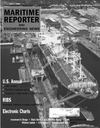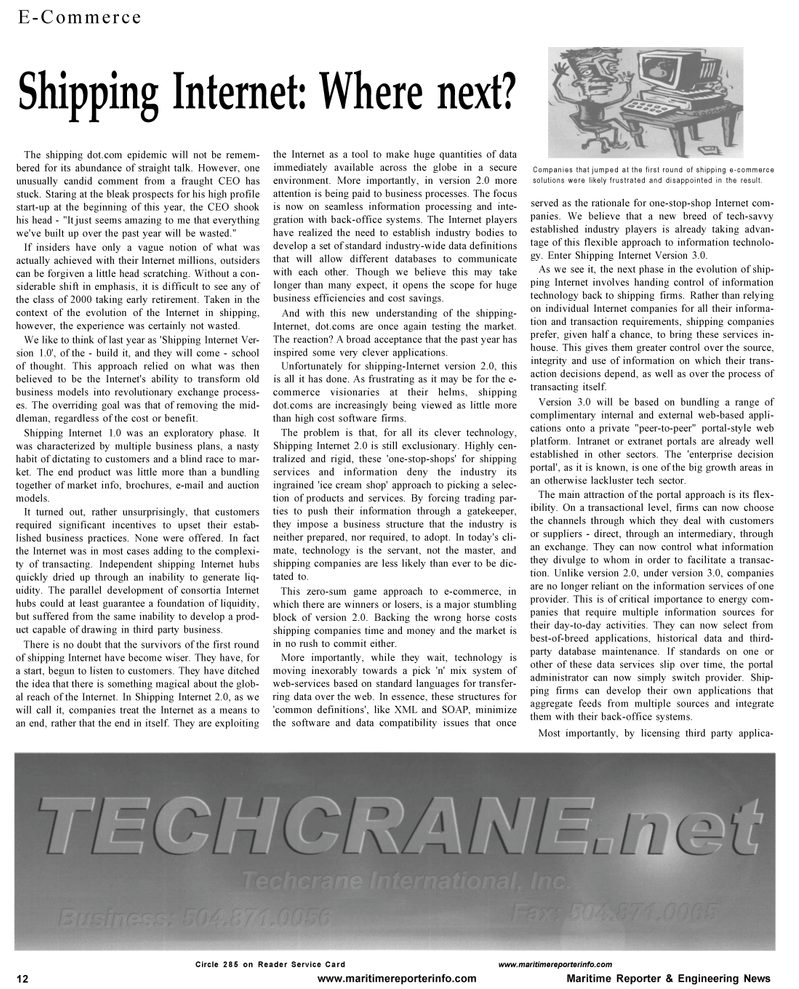
Page 14: of Maritime Reporter Magazine (August 2001)
Read this page in Pdf, Flash or Html5 edition of August 2001 Maritime Reporter Magazine
E-Commerce
Shipping Internet: Where next?
The shipping dot.com epidemic will not be remem- bered for its abundance of straight talk. However, one unusually candid comment from a fraught CEO has stuck. Staring at the bleak prospects for his high profile start-up at the beginning of this year, the CEO shook his head - "It just seems amazing to me that everything we've built up over the past year will be wasted."
If insiders have only a vague notion of what was actually achieved with their Internet millions, outsiders can be forgiven a little head scratching. Without a con- siderable shift in emphasis, it is difficult to see any of the class of 2000 taking early retirement. Taken in the context of the evolution of the Internet in shipping, however, the experience was certainly not wasted.
We like to think of last year as 'Shipping Internet Ver- sion 1.0', of the - build it, and they will come - school of thought. This approach relied on what was then believed to be the Internet's ability to transform old business models into revolutionary exchange process- es. The overriding goal was that of removing the mid- dleman, regardless of the cost or benefit.
Shipping Internet 1.0 was an exploratory phase. It was characterized by multiple business plans, a nasty habit of dictating to customers and a blind race to mar- ket. The end product was little more than a bundling together of market info, brochures, e-mail and auction models.
It turned out, rather unsurprisingly, that customers required significant incentives to upset their estab- lished business practices. None were offered. In fact the Internet was in most cases adding to the complexi- ty of transacting. Independent shipping Internet hubs quickly dried up through an inability to generate liq- uidity. The parallel development of consortia Internet hubs could at least guarantee a foundation of liquidity, but suffered from the same inability to develop a prod- uct capable of drawing in third party business.
There is no doubt that the survivors of the first round of shipping Internet have become wiser. They have, for a start, begun to listen to customers. They have ditched the idea that there is something magical about the glob- al reach of the Internet. In Shipping Internet 2.0, as we will call it, companies treat the Internet as a means to an end, rather that the end in itself. They are exploiting the Internet as a tool to make huge quantities of data immediately available across the globe in a secure environment. More importantly, in version 2.0 more attention is being paid to business processes. The focus is now on seamless information processing and inte- gration with back-office systems. The Internet players have realized the need to establish industry bodies to develop a set of standard industry-wide data definitions that will allow different databases to communicate with each other. Though we believe this may take longer than many expect, it opens the scope for huge business efficiencies and cost savings.
And with this new understanding of the shipping-
Internet, dot.coms are once again testing the market.
The reaction? A broad acceptance that the past year has inspired some very clever applications.
Unfortunately for shipping-Internet version 2.0, this is all it has done. As frustrating as it may be for the e- commerce visionaries at their helms, shipping dot.coms are increasingly being viewed as little more than high cost software firms.
The problem is that, for all its clever technology,
Shipping Internet 2.0 is still exclusionary. Highly cen- tralized and rigid, these 'one-stop-shops' for shipping services and information deny the industry its ingrained 'ice cream shop' approach to picking a selec- tion of products and services. By forcing trading par- ties to push their information through a gatekeeper, they impose a business structure that the industry is neither prepared, nor required, to adopt. In today's cli- mate, technology is the servant, not the master, and shipping companies are less likely than ever to be dic- tated to.
This zero-sum game approach to e-commerce, in which there are winners or losers, is a major stumbling block of version 2.0. Backing the wrong horse costs shipping companies time and money and the market is in no rush to commit either.
More importantly, while they wait, technology is moving inexorably towards a pick 'n' mix system of web-services based on standard languages for transfer- ring data over the web. In essence, these structures for 'common definitions', like XML and SOAP, minimize the software and data compatibility issues that once
Companies that jumped at the first round of shipping e-commerce solutions were likely frustrated and disappointed in the result. served as the rationale for one-stop-shop Internet com- panies. We believe that a new breed of tech-savvy established industry players is already taking advan- tage of this flexible approach to information technolo- gy. Enter Shipping Internet Version 3.0.
As we see it, the next phase in the evolution of ship- ping Internet involves handing control of information technology back to shipping firms. Rather than relying on individual Internet companies for all their informa- tion and transaction requirements, shipping companies prefer, given half a chance, to bring these services in- house. This gives them greater control over the source, integrity and use of information on which their trans- action decisions depend, as well as over the process of transacting itself.
Version 3.0 will be based on bundling a range of complimentary internal and external web-based appli- cations onto a private "peer-to-peer" portal-style web platform. Intranet or extranet portals are already well established in other sectors. The 'enterprise decision portal', as it is known, is one of the big growth areas in an otherwise lackluster tech sector.
The main attraction of the portal approach is its flex- ibility. On a transactional level, firms can now choose the channels through which they deal with customers or suppliers - direct, through an intermediary, through an exchange. They can now control what information they divulge to whom in order to facilitate a transac- tion. Unlike version 2.0, under version 3.0, companies are no longer reliant on the information services of one provider. This is of critical importance to energy com- panies that require multiple information sources for their day-to-day activities. They can now select from best-of-breed applications, historical data and third- party database maintenance. If standards on one or other of these data services slip over time, the portal administrator can now simply switch provider. Ship- ping firms can develop their own applications that aggregate feeds from multiple sources and integrate them with their back-office systems.
Most importantly, by licensing third party applica- 12
Circle 285 on Reader Service Card www.maritimereporterinfo.com www.maritimereporterinfo.com Maritime Reporter & Engineering News

 13
13

 15
15
